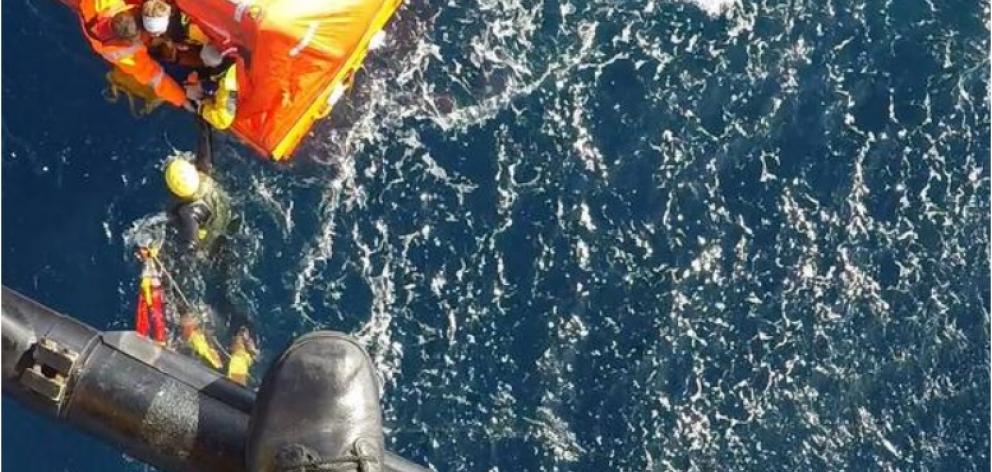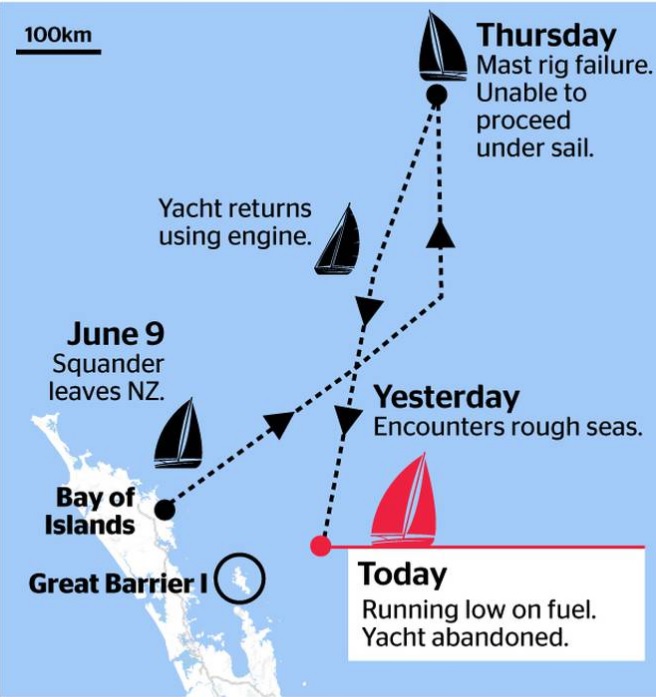
After being battered by headwinds for four days, the four crew members of the Squander climbed into a life raft and watched as their 14m masthead cutter drifted away.
They had activated a distress signal, which sparked a dramatic rescue mission was that culminated today with the four sailors being winched aboard a rescue helicopter cold, wet, but alive.
The two men and two women were plucked from the life raft shortly after midday today.
Their terrifying ordeal was documented in a blow by blow account in an online sailing forum.
It shows the crew growing more concerned as the journey progressed.
On Saturday the crew posted: "Very rough night, 40knots, waves in cockpit. Can?t maintain course,limited control of vessel.Crew hanging in there [sic]."
Then a final post at 7.36am today read: "Cannot make headway to the west. Compromised jury rig can only sail on starboard tack and this is limited. Options narrowing. Will run out of diesel and can only sail to the east. Options commercial tow or initiate distress call. 4th day battling headwinds."

Maritime New Zealand has today issued a warning to boaties that the Squander is now drifting unmanned in the Pacific Ocean.
The vessel was bound for Tonga when it left Opua in the Far North on June 9.
It suffered rigging damage on June 12 and was forced to turn back towards New Zealand.
However, last night the yacht could not maintain its course as waves crashed into the cockpit.
Early this morning the crew's options began to dwindle, diesel was running low as it continued to battle headwinds.
About 9.30am the crew abandoned ship 90km east-northeast of Great Barrier Island and activated a distress call from its emergency beacon.
Rescue Coordination Centre NZ (RCCNZ) was already monitoring the yacht's position, having earlier been alerted by satellite phone that the damaged ship was turning back to New Zealand.
A Maersk container ship in the area was able to get near the stricken yachties but was unable to make the rescue.
Two Auckland Westpac Rescue helicopters flew to the scene, and one was able to successfully winch the group from their life raft at 12.30pm.
Chief paramedic Karl Tayler extracted all four patients with the help of crew chief Mark Cannell.
Cannell said the conditions were too dangerous for the container ship to make the rescue itself.
There was a reasonably stiff offshore breeze with swells bringing the waves up just over two metres, he said.
"It was a little bit challenging just getting them out of the life raft but it certainly helped that they were well prepared.
"They were still fit and able."
The group had tethered the yacht's emergency locator beacon to the life raft, drawing emergency personnel towards them with accuracy.
The helicopter was only overhead for 13 minutes as they pulled each person up individually, he said.
"They were pretty elated [to be rescued] but I think not long after the extraction the enormity of what happened and their loss had started to sink in.
"It was a pretty traumatic sort of thing to have to do but they did everything right."
The group were flown back to Auckland to receive clearance from Customs.
RCCNZ Manager Mike Hill said the rescue highlighted how important it was to carry the appropriate emergency communications equipment.
"If you can't make contact, no one will know you need to be rescued."
This crew were well equipped for the journey they were undertaking and had a distress beacon, satellite phone, HF radio and VHF radio, Hill said.
"As a result, they had the right communications device for their location and were able to let us quickly know when they needed RCCNZ's assistance."
The four people were reportedly shaken but only suffered minor injuries.
The Squander was made in France 2003, and has been sailed extensively across the globe by two previous live-aboard owners.












